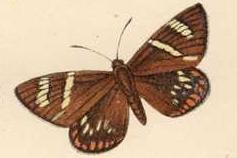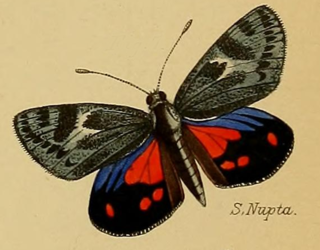
Castniidae, or castniid moths, is a small family of moths with fewer than 200 species: The majority are Neotropical with some in Australia and a few in south-east Asia. These are medium-sized to very large moths, usually with drab, cryptically marked forewings and brightly coloured hindwings. They have clubbed antennae and are day flying, and are often mistaken for butterflies. Indeed, some previous classification systems placed this family within the butterflies or skippers. The Neotropical species are commonly known as giant butterfly-moths, the Australian and Asian species as sun moths. The larvae are internal feeders, often on roots of epiphytes or on monocotyledons.

Synemon sophia is a moth in the Castniidae family. It is found in Australia, including Western Australia, Victoria and South Australia.
Synemon jcaria, the reddish-orange sun-moth, is a moth in the Castniidae family. It is found in Australia, including Victoria.

Xanthocastnia is a genus of moths within the family Castniidae containing only one species, Xanthocastnia evalthe, which is widespread in the Neotropical realm, ranging from southern Mexico to southern Brazil.

Geyeria is a genus of moths within the family Castniidae.
Synemon selene, the pale sun-moth, is a moth in the Castniidae family. It is found in Australia, including Victoria and South Australia.

Synemon notha is a moth in the Castniidae family. It is found in Australia, including Western Australia.

Synemon nupta is a moth in the Castniidae family. It is found in Australia, including Western Australia.

Amauta papilionaris is a moth in the Castniidae family. It is found in Colombia, Venezuela, Peru, Bolivia, Ecuador and Panama.
Eupalamides guyanensis is a moth in the Castniidae family. It is widely distributed in northern South America, from Venezuela to Guyana, Colombia and Brazil (Pará).

Corybantes mathani is a moth in the Castniidae family. It is found in South America, including Venezuela, Guyana and Peru.
Telchin syphax is a moth in the Castniidae family. It is widely distributed in the Amazon basin in South America.
Castnius pelasgus is a moth in the Castniidae family. It is found in Suriname, Peru and Amazonas.
Castnia fernandezi is a moth in the Castniidae family. It is found in Venezuela.

Imara satrapes is a moth in the Castniidae family. It is found in Brazil, Paraguay and Uruguay.

Hista fabricii is a moth in the Castniidae family. It is found in Brazil. It mainly occurs in the southern and south-eastern parts of the country, in areas of the Atlantic Forest.
Lapaeumides zerynthia is a moth in the Castniidae family. It is found in Brazil, in the Neotropical realm. This species is likely found in lowland tropical forests, but future research is needed to confirm this.

Ceretes thais is a moth in the Castniidae family. It is found in Brazil. Superficially it looks very like a butterfly, and was originally placed by Dru Drury in the "Papilio " group which mostly corresponds with modern Nymphalidae.

Schistostege decussata is a moth of the family Geometridae. It is found in south-eastern and eastern Europe up to Ukraine. In Hungary and Lower Austria, the yellow-brown form is found.
Cyclophora decussata is a moth in the family Geometridae. It is found in Suriname, French Guiana and Brazil.











